Input interpretation

O_2 oxygen + NH_3 ammonia ⟶ H_2O water + N_2O nitrous oxide
Balanced equation
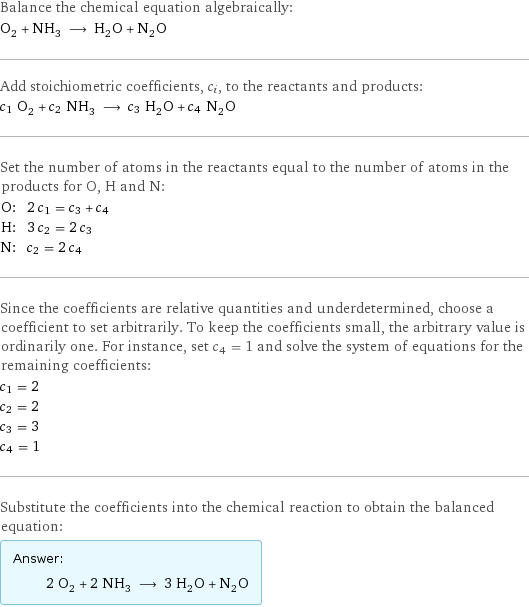
Balance the chemical equation algebraically: O_2 + NH_3 ⟶ H_2O + N_2O Add stoichiometric coefficients, c_i, to the reactants and products: c_1 O_2 + c_2 NH_3 ⟶ c_3 H_2O + c_4 N_2O Set the number of atoms in the reactants equal to the number of atoms in the products for O, H and N: O: | 2 c_1 = c_3 + c_4 H: | 3 c_2 = 2 c_3 N: | c_2 = 2 c_4 Since the coefficients are relative quantities and underdetermined, choose a coefficient to set arbitrarily. To keep the coefficients small, the arbitrary value is ordinarily one. For instance, set c_4 = 1 and solve the system of equations for the remaining coefficients: c_1 = 2 c_2 = 2 c_3 = 3 c_4 = 1 Substitute the coefficients into the chemical reaction to obtain the balanced equation: Answer: | | 2 O_2 + 2 NH_3 ⟶ 3 H_2O + N_2O
Structures

+ ⟶ +
Names

oxygen + ammonia ⟶ water + nitrous oxide
Reaction thermodynamics
Enthalpy
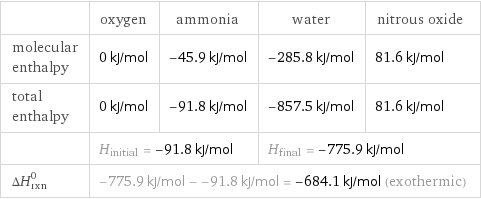
| oxygen | ammonia | water | nitrous oxide molecular enthalpy | 0 kJ/mol | -45.9 kJ/mol | -285.8 kJ/mol | 81.6 kJ/mol total enthalpy | 0 kJ/mol | -91.8 kJ/mol | -857.5 kJ/mol | 81.6 kJ/mol | H_initial = -91.8 kJ/mol | | H_final = -775.9 kJ/mol | ΔH_rxn^0 | -775.9 kJ/mol - -91.8 kJ/mol = -684.1 kJ/mol (exothermic) | | |
Gibbs free energy
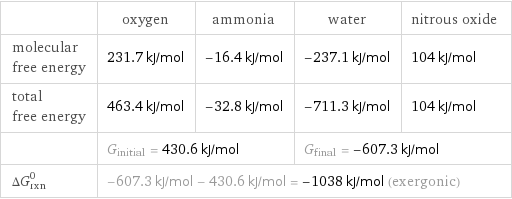
| oxygen | ammonia | water | nitrous oxide molecular free energy | 231.7 kJ/mol | -16.4 kJ/mol | -237.1 kJ/mol | 104 kJ/mol total free energy | 463.4 kJ/mol | -32.8 kJ/mol | -711.3 kJ/mol | 104 kJ/mol | G_initial = 430.6 kJ/mol | | G_final = -607.3 kJ/mol | ΔG_rxn^0 | -607.3 kJ/mol - 430.6 kJ/mol = -1038 kJ/mol (exergonic) | | |
Entropy
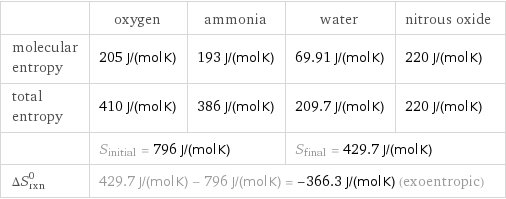
| oxygen | ammonia | water | nitrous oxide molecular entropy | 205 J/(mol K) | 193 J/(mol K) | 69.91 J/(mol K) | 220 J/(mol K) total entropy | 410 J/(mol K) | 386 J/(mol K) | 209.7 J/(mol K) | 220 J/(mol K) | S_initial = 796 J/(mol K) | | S_final = 429.7 J/(mol K) | ΔS_rxn^0 | 429.7 J/(mol K) - 796 J/(mol K) = -366.3 J/(mol K) (exoentropic) | | |
Equilibrium constant
![Construct the equilibrium constant, K, expression for: O_2 + NH_3 ⟶ H_2O + N_2O Plan: • Balance the chemical equation. • Determine the stoichiometric numbers. • Assemble the activity expression for each chemical species. • Use the activity expressions to build the equilibrium constant expression. Write the balanced chemical equation: 2 O_2 + 2 NH_3 ⟶ 3 H_2O + N_2O Assign stoichiometric numbers, ν_i, using the stoichiometric coefficients, c_i, from the balanced chemical equation in the following manner: ν_i = -c_i for reactants and ν_i = c_i for products: chemical species | c_i | ν_i O_2 | 2 | -2 NH_3 | 2 | -2 H_2O | 3 | 3 N_2O | 1 | 1 Assemble the activity expressions accounting for the state of matter and ν_i: chemical species | c_i | ν_i | activity expression O_2 | 2 | -2 | ([O2])^(-2) NH_3 | 2 | -2 | ([NH3])^(-2) H_2O | 3 | 3 | ([H2O])^3 N_2O | 1 | 1 | [N2O] The equilibrium constant symbol in the concentration basis is: K_c Mulitply the activity expressions to arrive at the K_c expression: Answer: | | K_c = ([O2])^(-2) ([NH3])^(-2) ([H2O])^3 [N2O] = (([H2O])^3 [N2O])/(([O2])^2 ([NH3])^2)](../image_source/121fc842feb99fa8f500e5c85d767c6c.png)
Construct the equilibrium constant, K, expression for: O_2 + NH_3 ⟶ H_2O + N_2O Plan: • Balance the chemical equation. • Determine the stoichiometric numbers. • Assemble the activity expression for each chemical species. • Use the activity expressions to build the equilibrium constant expression. Write the balanced chemical equation: 2 O_2 + 2 NH_3 ⟶ 3 H_2O + N_2O Assign stoichiometric numbers, ν_i, using the stoichiometric coefficients, c_i, from the balanced chemical equation in the following manner: ν_i = -c_i for reactants and ν_i = c_i for products: chemical species | c_i | ν_i O_2 | 2 | -2 NH_3 | 2 | -2 H_2O | 3 | 3 N_2O | 1 | 1 Assemble the activity expressions accounting for the state of matter and ν_i: chemical species | c_i | ν_i | activity expression O_2 | 2 | -2 | ([O2])^(-2) NH_3 | 2 | -2 | ([NH3])^(-2) H_2O | 3 | 3 | ([H2O])^3 N_2O | 1 | 1 | [N2O] The equilibrium constant symbol in the concentration basis is: K_c Mulitply the activity expressions to arrive at the K_c expression: Answer: | | K_c = ([O2])^(-2) ([NH3])^(-2) ([H2O])^3 [N2O] = (([H2O])^3 [N2O])/(([O2])^2 ([NH3])^2)
Rate of reaction
![Construct the rate of reaction expression for: O_2 + NH_3 ⟶ H_2O + N_2O Plan: • Balance the chemical equation. • Determine the stoichiometric numbers. • Assemble the rate term for each chemical species. • Write the rate of reaction expression. Write the balanced chemical equation: 2 O_2 + 2 NH_3 ⟶ 3 H_2O + N_2O Assign stoichiometric numbers, ν_i, using the stoichiometric coefficients, c_i, from the balanced chemical equation in the following manner: ν_i = -c_i for reactants and ν_i = c_i for products: chemical species | c_i | ν_i O_2 | 2 | -2 NH_3 | 2 | -2 H_2O | 3 | 3 N_2O | 1 | 1 The rate term for each chemical species, B_i, is 1/ν_i(Δ[B_i])/(Δt) where [B_i] is the amount concentration and t is time: chemical species | c_i | ν_i | rate term O_2 | 2 | -2 | -1/2 (Δ[O2])/(Δt) NH_3 | 2 | -2 | -1/2 (Δ[NH3])/(Δt) H_2O | 3 | 3 | 1/3 (Δ[H2O])/(Δt) N_2O | 1 | 1 | (Δ[N2O])/(Δt) (for infinitesimal rate of change, replace Δ with d) Set the rate terms equal to each other to arrive at the rate expression: Answer: | | rate = -1/2 (Δ[O2])/(Δt) = -1/2 (Δ[NH3])/(Δt) = 1/3 (Δ[H2O])/(Δt) = (Δ[N2O])/(Δt) (assuming constant volume and no accumulation of intermediates or side products)](../image_source/fbb7ae933f4ea8915d7e0ae70d7dfa72.png)
Construct the rate of reaction expression for: O_2 + NH_3 ⟶ H_2O + N_2O Plan: • Balance the chemical equation. • Determine the stoichiometric numbers. • Assemble the rate term for each chemical species. • Write the rate of reaction expression. Write the balanced chemical equation: 2 O_2 + 2 NH_3 ⟶ 3 H_2O + N_2O Assign stoichiometric numbers, ν_i, using the stoichiometric coefficients, c_i, from the balanced chemical equation in the following manner: ν_i = -c_i for reactants and ν_i = c_i for products: chemical species | c_i | ν_i O_2 | 2 | -2 NH_3 | 2 | -2 H_2O | 3 | 3 N_2O | 1 | 1 The rate term for each chemical species, B_i, is 1/ν_i(Δ[B_i])/(Δt) where [B_i] is the amount concentration and t is time: chemical species | c_i | ν_i | rate term O_2 | 2 | -2 | -1/2 (Δ[O2])/(Δt) NH_3 | 2 | -2 | -1/2 (Δ[NH3])/(Δt) H_2O | 3 | 3 | 1/3 (Δ[H2O])/(Δt) N_2O | 1 | 1 | (Δ[N2O])/(Δt) (for infinitesimal rate of change, replace Δ with d) Set the rate terms equal to each other to arrive at the rate expression: Answer: | | rate = -1/2 (Δ[O2])/(Δt) = -1/2 (Δ[NH3])/(Δt) = 1/3 (Δ[H2O])/(Δt) = (Δ[N2O])/(Δt) (assuming constant volume and no accumulation of intermediates or side products)
Chemical names and formulas
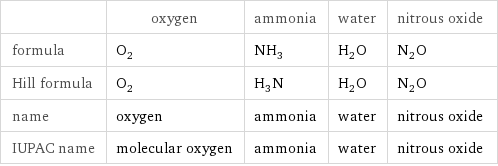
| oxygen | ammonia | water | nitrous oxide formula | O_2 | NH_3 | H_2O | N_2O Hill formula | O_2 | H_3N | H_2O | N_2O name | oxygen | ammonia | water | nitrous oxide IUPAC name | molecular oxygen | ammonia | water | nitrous oxide